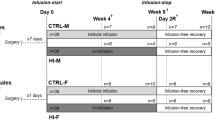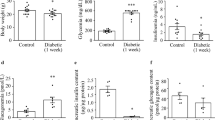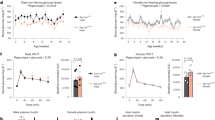Abstract
Objective:
Obesity is associated with high insulin and glucagon plasma levels. Enhanced β-cell function and β-cell expansion are responsible for insulin hypersecretion. It is unknown whether hyperglucagonemia is due to α-cell hypersecretion or to an increase in α-cell mass. In this study, we investigated the dynamics of the β-cell and α-cell function and mass in pancreas of obese normoglycemic baboons.
Methods:
Pancreatic β- and α-cell volumes were measured in 51 normoglycemic baboons divided into six groups according to overweight severity or duration. Islets morphometric parameters were correlated to overweight and to diverse metabolic and laboratory parameters.
Results:
Relative α-cell volume (RαV) and relative islet α-cell volume (RIαV) increased significantly with both overweight duration and severity. Conversely, in spite of the induction of insulin resistance, overweight produced only modest effects on relative β-cell volume (RβV) and relative islet β-cell volume (RIβV). Of note, RIβV did not increase neither with overweight duration nor with overweight severity, supposedly because of the concomitant, greater increase in RIαV. Baboons’ body weights correlated with serum levels of interleukin-6 and tumor necrosis factor-α soluble receptors, demonstrating that overweight induces abnormal activation of the signaling of two cytokines known to impact differently β- and α-cell viability and replication.
Conclusion:
In conclusion, overweight and insulin resistance induce in baboons a significant increase in α-cell volumes (RαV, RIαV), whereas have minimal effects on the β cells. This study suggests that an increase in the α-cell mass may precede the loss of β cells and the transition to overt hyperglycemia and diabetes.
This is a preview of subscription content, access via your institution
Access options
Subscribe to this journal
Receive 12 print issues and online access
$259.00 per year
only $21.58 per issue
Buy this article
- Purchase on Springer Link
- Instant access to full article PDF
Prices may be subject to local taxes which are calculated during checkout





Similar content being viewed by others
References
Unger RH, Orci L . Paracrinology of islets and the paracrinopathy of diabetes. Proc Natl Acad Sci USA 2010; 107: 16009–16012.
Quinn AR, Blanco C, Perego C, Finzi G, La Rosa S, Capella C et al. The ontogeny of the endocrine pancreas in the fetal/newborn baboon. J Endocrinol 2012; 214: 289–299.
Bouwens L, Rooman I . Regulation of pancreatic beta-cell mass. Physiol Rev 2005; 85: 1255–1270.
Bonner-Weir S . Perspective: postnatal pancreatic beta cell growth. Endocrinology 2000; 141: 1926–1929.
Bonner-Weir S, Li WC, Ouziel-Yahalom L, Guo L, Weir GC, Sharma A . Beta-cell growth and regeneration: replication is only part of the story. Diabetes 2010; 59: 2340–2348.
Folli F, Okada T, Perego C, Gunton J, Liew CW, Akiyama M et al. Altered insulin receptor signalling and β-cell cycle dynamics in type 2 diabetes mellitus. PLoS One 2011; 6: e28050.
Butler AE, Janson J, Bonner-Weir S, Ritzel R, Rizza RA, Butler PC . Beta-cell deficit and increased beta-cell apoptosis in humans with type 2 diabetes. Diabetes 2003; 52: 102–110.
Camastra S, Manco M, Mari A, Baldi S, Gastaldelli A, Greco AV et al. beta-cell function in morbidly obese subjects during free living: long-term effects of weight loss. Diabetes 2005; 54: 2382–2389.
Clark A, Wells CA, Buley ID, Cruickshank JK, Vanhegan RI, Matthews DR et al. Islet amyloid, increased A-cells, reduced B-cells and exocrine fibrosis: quantitative changes in the pancreas in type 2 diabetes. Diabetes Res 1988; 9: 151–159.
Elder DA, Prigeon RL, Wadwa RP, Dolan LM, D'Alessio DA . Beta-cell function, insulin sensitivity, and glucose tolerance in obese diabetic and nondiabetic adolescents and young adults. J Clin Endocrinol Metab 2006; 91: 185–191.
Kloppel G, Lohr M, Habich K, Oberholzer M, Heitz PU . Islet pathology and the pathogenesis of type 1 and type 2 diabetes mellitus revisited. Surv Synth Pathol Res 1985; 4: 110–125.
Meier JJ . Beta cell mass in diabetes: a realistic therapeutic target? Diabetologia 2008; 51: 703–713.
Rahier J, Goebbels RM, Henquin JC . Cellular composition of the human diabetic pancreas. Diabetologia 1983; 24: 366–371.
Rahier J, Guiot Y, Goebbels RM, Sempoux C, Henquin JC . Pancreatic beta-cell mass in European subjects with type 2 diabetes. Diabetes Obes Metab 2008; 10 (Suppl 4): 32–42.
Sakuraba H, Mizukami H, Yagihashi N, Wada R, Hanyu C, Yagihashi S . Reduced beta-cell mass and expression of oxidative stress-related DNA damage in the islet of Japanese Type II diabetic patients. Diabetologia 2002; 45: 85–96.
Yoon KH, Ko SH, Cho JH, Lee JM, Ahn YB, Song KH et al. Selective beta-cell loss and alpha-cell expansion in patients with type 2 diabetes mellitus in Korea. J Clin Endocrinol Metab 2003; 88: 2300–2308.
Ferrannini E, Gastaldelli A, Miyazaki Y, Matsuda M, Mari A, DeFronzo RA . beta-Cell function in subjects spanning the range from normal glucose tolerance to overt diabetes: a new analysis. J Clin Endocrinol Metab 2005; 90: 493–500.
Saisho Y, Butler AE, Manesso E, Elashoff D, Rizza RA, Butler PC . β-Cell Mass and Turnover in Humans: Effects of obesity and aging. Diabetes Care 2012. e-pub ahead of print 8 Aug 2012.
Starke AA, Erhardt G, Berger M, Zimmermann H . Elevated pancreatic glucagon in obesity. Diabetes 1984; 33: 277–280.
Asano T, Ninomiya H, Kan K, Yamamoto T, Okumura M . Plasma glucagon response to intravenous alanine in obese and non-obese subjects. Endocrinol Jpn 1989; 36: 767–773.
Ferrannini E, Muscelli E, Natali A, Gabriel R, Mitrakou A, Flyvbjerg A et al. Association of fasting glucagon and proinsulin concentrations with insulin resistance. Diabetologia 2007; 50: 2342–2347.
Solerte SB, Rondanelli M, Giacchero R, Stabile M, Lovati E, Cravello L et al. Serum glucagon concentration and hyperinsulinaemia influence renal haemodynamics and urinary protein loss in normotensive patients with central obesity. Int J Obes Relat Metab Disord 1999; 23: 997–1003.
Weiss R, D'Adamo E, Santoro N, Hershkop K, Caprio S . Basal alpha-cell up-regulation in obese insulin-resistant adolescents. J Clin Endocrinol Metab 2011; 96: 91–97.
Guardado-Mendoza R, Davalli AM, Chavez AO, Hubbard GB, Dick EJ, Majluf-Cruz A et al. Pancreatic islet amyloidosis, beta-cell apoptosis, and alpha-cell proliferation are determinants of islet remodeling in type-2 diabetic baboons. Proc Natl Acad Sci USA 2009; 106: 13992–13997.
Freere RH, Weibel ER . Stereologic techniques in microscopy. J R Microsc Soc 1967; 87: 25–34.
Mandarim-de-Lacerda CA . Stereological tools in biomedical research. An Acad Bras Cienc 2003; 75: 469–486.
Matthews DR, Hosker JP, Rudenski AS, Naylor BA, Treacher DF, Turner RC . Homeostasis model assessment: insulin resistance and beta-cell function from fasting plasma glucose and insulin concentrations in man. Diabetologia 1985; 28: 412–419.
Chavez AO, Gastaldelli A, Guardado-Mendoza R, Lopez-Alvarenga JC, Leland MM, Tejero ME et al. Predictive models of insulin resistance derived from simple morphometric and biochemical indices related to obesity and the metabolic syndrome in baboons. Cardiovasc Diabetol 2009; 8: 22.
Chavez AO, Lopez-Alvarenga JC, Tejero ME, Triplitt C, Bastarrachea RA, Sriwijitkamol A et al. Physiological and molecular determinants of insulin action in the baboon. Diabetes 2008; 57: 899–908.
Folli F, Saad MJ, Backer JM, Kahn CR . Regulation of phosphatidylinositol 3-kinase activity in liver and muscle of animal models of insulin-resistant and insulin-deficient diabetes mellitus. J Clin Invest 1993; 92: 1787–1794.
Cusi K, Maezono K, Osman A, Pendergrass M, Patti ME, Pratipanawatr T et al. Insulin resistance differentially affects the PI 3-kinase- and MAP kinase-mediated signaling in human muscle. J Clin Invest 2000; 105: 311–320.
Jurgens CA, Toukatly MN, Fligner CL, Udayasankar J, Subramanian SL, Zraika S et al. β-cell loss and β-cell apoptosis in human type 2 diabetes are related to islet amyloid deposition. Am J Pathol 2011; 178: 2632–2640.
Gapp DA, Leiter EH, Coleman DL, Schwizer RW . Temporal changes in pancreatic islet composition in C57BL/6J-db/db (diabetes) mice. Diabetologia 1983; 25: 439–443.
Montanya E, Nacher V, Biarnes M, Soler J . Linear correlation between beta-cell mass and body weight throughout the lifespan in Lewis rats: role of beta-cell hyperplasia and hypertrophy. Diabetes 2000; 49: 1341–1346.
Pick A, Clark J, Kubstrup C, Levisetti M, Pugh W, Bonner-Weir S et al. Role of apoptosis in failure of beta-cell mass compensation for insulin resistance and beta-cell defects in the male Zucker diabetic fatty rat. Diabetes 1998; 47: 358–364.
Bock T, Kyhnel A, Pakkenberg B, Buschard K . The postnatal growth of the beta-cell mass in pigs. J Endocrinol 2003; 179: 245–252.
Reers C, Erbel S, Esposito I, Schmied B, Buchler MW, Nawroth PP et al. Impaired islet turnover in human donor pancreata with aging. Eur J Endocrinol 2009; 160: 185–191.
Tyrberg B, Eizirik DL, Hellerstrom C, Pipeleers DG, Andersson A . Human pancreatic beta-cell deoxyribonucleic acid-synthesis in islet grafts decreases with increasing organ donor age but increases in response to glucose stimulation in vitro. Endocrinology 1996; 137: 5694–5699.
Gromada J, Franklin I, Wollheim CB . Alpha-cells of the endocrine pancreas: 35 years of research but the enigma remains. Endocr Rev 2007; 28: 84–116.
Unger RH, Orci L . The essential role of glucagon in the pathogenesis of diabetes mellitus. Lancet 1975; 1: 14–16.
Cardellini M, Perego L, D’Adamo M, Marini MA, Procopio C, Hribal ML et al. C-174G polymorphism in the promoter of the interleukin-6 gene is associated with insulin resistance. Diabetes Care 2005; 28: 2007–2012.
Marques-Vidal P, Bastardot F, von Känel R, Paccaud F, Preisig M, Waeber G et al. Association between circulating cytokine levels, diabetes and insulin resistance in a population-based sample (CoLaus study). Clin Endocrinol (Oxf) 2012. e-pub ahead of print 12 Mar 2012. doi:10.1111/j.1365-2265.2012.04384.x.
Browning LM, Krebs JD, Magee EC, Frühbeck G, Jebb SA . Circulating markers of inflammation and their link to indices of adiposity. Obes Facts 2008; 1: 259–265.
Ellingsgaard H, Ehses JA, Hammar EB, Van Lommel L, Quintens R, Martens G et al. Interleukin-6 regulates pancreatic alpha-cell mass expansion. Proc Natl Acad Sci USA 2008; 105: 13163–13168.
Bertrand G, Gross R, Puech R, Loubatieres-Mariani MM, Bockaert J . Glutamate stimulates glucagon secretion via an excitatory amino acid receptor of the AMPA subtype in rat pancreas. Eur J Pharmacol 1993; 237: 45–50.
Brice NL, Varadi A, Ashcroft SJ, Molnar E . Metabotropic glutamate and GABA(B) receptors contribute to the modulation of glucose-stimulated insulin secretion in pancreatic beta cells. Diabetologia 2002; 45: 242–252.
Cabrera O, Jacques-Silva MC, Speier S, Yang SN, Kohler M, Fachado A et al. Glutamate is a positive autocrine signal for glucagon release. Cell Metab 2008; 7: 545–554.
Cho JH, Chen L, Kim MH, Chow RH, Hille B, Koh DS . Characteristics and functions of {alpha}-amino-3-hydroxy-5-methyl-4-isoxazolepropionate receptors expressed in mouse pancreatic {alpha}-cells. Endocrinology 2010; 151: 1541–1550.
Hayashi M, Yamada H, Uehara S, Morimoto R, Muroyama A, Yatsushiro S et al. Secretory granule-mediated co-secretion of L-glutamate and glucagon triggers glutamatergic signal transmission in islets of Langerhans. J Biol Chem 2003; 278: 1966–1974.
Maechler P, Wollheim CB . Mitochondrial glutamate acts as a messenger in glucose-induced insulin exocytosis. Nature 1999; 402: 685–689.
Uehara S, Muroyama A, Echigo N, Morimoto R, Otsuka M, Yatsushiro S et al. Metabotropic glutamate receptor type 4 is involved in autoinhibitory cascade for glucagon secretion by alpha-cells of islet of Langerhans. Diabetes 2004; 53: 998–1006.
Di Cairano ES, Davalli AM, Perego L, Sala S, Sacchi VF, La Rosa S et al. The glial glutamate transporter 1 (GLT1) is expressed by pancreatic beta-cells and prevents glutamate-induced beta-cell death. J Biol Chem 2011; 286: 14007–14018.
Ahren B . Beta- and alpha-cell dysfunction in subjects developing impaired glucose tolerance: outcome of a 12-year prospective study in postmenopausal Caucasian women. Diabetes 2009; 58: 726–731.
Dunning BE, Gerich JE . The role of alpha-cell dysregulation in fasting and postprandial hyperglycemia in type 2 diabetes and therapeutic implications. Endocr Rev 2007; 28: 253–283.
Federici M, Hribal M, Perego L, Ranalli M, Caradonna Z, Perego C et al. High glucose causes apoptosis in cultured human pancreatic islets of Langerhans: a potential role for regulation of specific Bcl family genes toward an apoptotic cell death program. Diabetes 2001; 50: 1290–1301.
Acknowledgements
RG-M was supported by SANOFI endocrine fellowship. TVF was supported in part by fellowship from FO.RI.SID. This work was partially supported by NIH RO1 DK080148 (FF).
Author information
Authors and Affiliations
Corresponding author
Ethics declarations
Competing interests
The authors declare no conflict of interest.
Additional information
Supplementary Information accompanies the paper on International Journal of Obesity website
Rights and permissions
About this article
Cite this article
Guardado-Mendoza, R., Jimenez-Ceja, L., Majluf-Cruz, A. et al. Impact of obesity severity and duration on pancreatic β- and α-cell dynamics in normoglycemic non-human primates. Int J Obes 37, 1071–1078 (2013). https://doi.org/10.1038/ijo.2012.205
Received:
Revised:
Accepted:
Published:
Issue Date:
DOI: https://doi.org/10.1038/ijo.2012.205
Keywords
This article is cited by
-
Vitamin D, sub-inflammation and insulin resistance. A window on a potential role for the interaction between bone and glucose metabolism
Reviews in Endocrine and Metabolic Disorders (2017)
-
Pancreatic alpha-cells from female mice undergo morphofunctional changes during compensatory adaptations of the endocrine pancreas to diet-induced obesity
Scientific Reports (2015)
-
New insights into the architecture of the islet of Langerhans: a focused cross-species assessment
Diabetologia (2015)
-
Delta cell death in the islet of Langerhans and the progression from normal glucose tolerance to type 2 diabetes in non-human primates (baboon, Papio hamadryas)
Diabetologia (2015)
-
Recent progress in studies of factors that elicit pancreatic β-cell expansion
Protein & Cell (2015)



